Winter Wonderland: ww.inf.ed.ac.uk
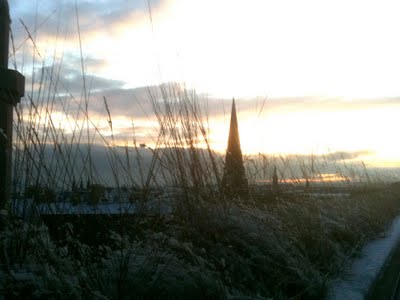 Today we had a snowball fight. See picasa for more images of the roof garden in the snow.
Today we had a snowball fight. See picasa for more images of the roof garden in the snow.Labels: edinburgh, forum, informatics, snow, winter
Public News and Announcements Blog from the School of Informatics at the University of Edinburgh.
 Today we had a snowball fight. See picasa for more images of the roof garden in the snow.
Today we had a snowball fight. See picasa for more images of the roof garden in the snow.Labels: edinburgh, forum, informatics, snow, winter
I am delighted to announce that Robin Milner is returning to the University of Edinburgh, part-time. He will be a SICSA Advanced Research Fellow and will hold the Chair of Computer Science.
Robin Milner graduated from Cambridge in 1958. After short posts he joined the University of Edinburgh in 1973, where he co-founded the Laboratory for Foundation of Computer Science in 1986. He was elected Fellow of the Royal Society in 1988, and in 1991 won the ACM's A.M. Turing Award. He joined Cambridge University in 1995, headed the Computer Laboratory there for four years, and retired in 2001. His research achievements (often joint) include: the system LCF, a model for many later systems for interactive reasoning; Standard ML, an industry-scale but rigorously based programming language; the Calculus of Communicating Systems (CCS); the Pi Calculus.
Currently he works on Bigraphs, a topographical model which aims to provide a theoretical foundation for mobile interactive systems. Cambridge University Press has just published The Space and Motion of Communicating Agents, Robin's book on this area.
Robin will be giving a short course on bigraphs in Edinburgh on May 13th and 14th 2009. So that we can keep track of numbers, please sign up for the course at http://milner-bigraphs.eventbrite.com (password is milner).
Labels: appointment, bigraphs, computation, edinburgh, forum, informatics, milner, mobility, model, sicsa, ubiquitous
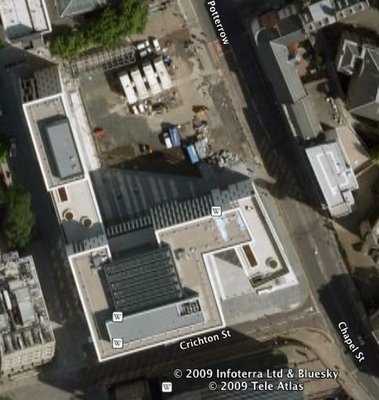
Google has updated Google Earth with new images for Edinburgh Southside, dated 21 July 2008.
Open the title link with Google Earth to see the George Square masterplan superimposed on the Forum.
Labels: earth, edinburgh, forum, google, informatics, potterrow, university
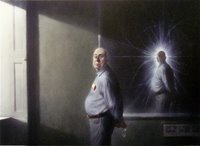
Peter Higgs was the first student of Christopher Longuet-Higgins, one of the forefathers of Informatics at Edinburgh.
The School is delighted to host Peter's recent portrait by Ken Currie. The portrait will hang in the Forum for the next few months, until it moves to its permanent home in the James Clerk Maxwell Building.
Mark Steedman and David Willshaw were also students of Longuet-Higgins.
Labels: art, forum, Ken Currie, peter higgs, portrait
So, the Forum is Number Two Crichton Street. Appleton Tower (11 Crichton Street) is Number Three.
We're now working on Number One - inSpace, our workshop, gallery and public engagement space for Informatics and Creativity, being fitted out for opening next year, on the corner with Potterrow.
Guardian critics pick this autumn's unmissable shows
Architecture
Informatics Forum, University of Edinburgh*
Autumn at the University of Edinburgh will see the opening of this wonderful research centre designed for a faculty that brings together biology, neurology, linguistics and art. It looks like a see-through Rubik's Cube.
Don't miss it on Open Doors day 27th September
What is BREEAM?
BREEAM is the world's most widely used environmental assessment method for buildings.
Informatics@Edinburgh - number one in research, excellent in teaching - now also environmentally excellent!
Edinburgh University's School of Informatics is already the top computing science school in the UK and one of the leading four of its kind in the world.
Hume famously said, "The spirit of the age affects all the arts". In the age of information, informatics affects the arts, the sciences, and the humanities.
Labels: breeam, edinburgh, excellent, forum, herald, hume, informatics, news, scotsman, THES
Scottish First Minister Alex Salmond will open a world-leading centre for informatics research - encompassing computer science, artificial intelligence and cognitive science - at the University of Edinburgh on Wednesday, 3 September.
The £42 million Informatics Forum is dedicated to research from the University's School of Informatics. It brings together some 500 scientists whose interests span virtual reality, robotics, artificial learning, intelligent systems, computational linguistics and bioinformatics.
Built over six floors around a central glass atrium, the 12,000m2 Forum has an open design to encourage interaction and collaboration between researchers. This is intended to promote world-class research and reflect the school's reputation for commercialisation.
Mr Salmond will undertake a tour during which he will be shown examples of key research including a robotic hand prosthesis - being developed in collaboration with local company Touch Bionics - and a miniature humanoid robot. The First Minister will also see notable aspects of the building, such as its floating staircases and outdoor terraces. He is to formally open the Forum by switching on a digital donor board, on which the names of fundraising donors are illuminated in binary code.
The Forum was designed by Bennetts Associates Architects and built by Balfour Beatty, with financial support from Scottish Enterprise, the Scottish Government, the Wolfson Foundation, alumni and others.
Mr Salmond will also see sculptures from by Eduardo Paolozzi which are on display in the Forum. The works form part of a bequest which also includes a set of Paolozzi's Turing prints and 100 plaster maquettes.
Representatives of some 30 commercialisation projects associated with the school will be present at the event.
Informatics is the study of how natural and artificial systems store, process and communicate information. The University of Edinburgh's School of Informatics is rated as the top computing science school in the UK and among the top four in the world, with outstanding teaching and research facilities.
First Minister Alex Salmond said: "Scotland has firmly established its place as a world leader in informatics and the development of this impressive new facility reinforces our commitment to research in this area.
"This £42 million project will act as a hub for the academic, commercial and civil development of a range of informatics disciplines ranging from e-science and medicine to business and humanities.
"The Scottish Government is committed to promoting excellence and innovation - building on research and scientific excellence in Scotland's universities to promote sustainable economic growth. I am delighted to officially open this new centre of excellence, it will advance Scotland and the University of Edinburgh's position as a world leader in the new science of informatics and it will also have enormous benefits to both industry and commerce."
Professor Michael Fourman, Head of the School of Informatics, said: "We are delighted to formally open the Informatics Forum. Bringing together our first-rate researchers into this collaborative environment will enable new research, building on the successes of the School to date."
Linda McPherson, Operations Director at Scottish Enterprise said, "Excellence in research is vital for Scotland to compete globally, and the Informatics Forum offers a truly world class facility for this to happen. I am delighted to see the formal opening of the forum and the significant impact it will make to the future of Scotland's economy."
Labels: forum, informatics, opening, salmond
Marije ('Mariah', with 'i' pronounced 'a') Vugts, already known to those based at KB, has been appointed to the post of Migration Coordinator. She will work with David Wyse, Joanna Treichel, and a host of others within the School, the University, and the Potterrow Project Team, to ensure an orderly succession of moves from our current distributed state to a new order in the Forum and Appleton Tower.
Marije will be collecting information from various sources over the next few weeks, and I hereby request and require all those whom it may concern to afford her such assistance as may be necessary. Your prompt and full responses to her queries will be much appreciated.
We will hold the traditional Informatics Open Meeting at the end of induction week in September, and plans for migration will be the main topic for discussion.
Labels: appointment, forum, marije, migration, potterrow, vugts
Labels: construction, forum, informatics, inspace, potterrow
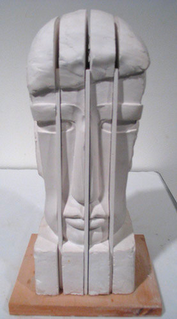

The University of Edinburgh announced, today, a major bequest from the estate of sculptor Eduardo Paolozzi, who died in April 2005. This includes a set of Paolozzi’s “Turing” prints, together with four sculptures in chrome and bronze, and one hundred plaster maquettes by the world-renowned Scottish artist.
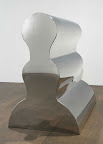 These works will be housed in the Informatics Forum, the new home for the University’s School of Informatics, currently under construction in Edinburgh. The Forum, an 11,500 metre building on Crichton Street in the centre of Edinburgh’s Southside, will open in 2008. It will house some 500 researchers and also InSpace, an accessible space dedicated to public understanding and exploration of the cultural significance of informatics.
These works will be housed in the Informatics Forum, the new home for the University’s School of Informatics, currently under construction in Edinburgh. The Forum, an 11,500 metre building on Crichton Street in the centre of Edinburgh’s Southside, will open in 2008. It will house some 500 researchers and also InSpace, an accessible space dedicated to public understanding and exploration of the cultural significance of informatics.
Professor Michael Fourman, Head of the School of Informatics, said the School was delighted to receive the bequest.
“Paolozzi was intrigued by genius and creativity. His heroes, Leonardo, Einstein, Wittgenstein, Freud, and Turing sought to explore the inner workings of the mind, the body and the world.
“He was fascinated by the relationship between the organic and the artificial, the representational and the abstract; the relationship between man and machine. These themes are central to our research, and these artworks will be used to help visitors engage with science of informatics.
"At a practical level, Paolozzi’s work explores themes of modularity and seriality, or repetition. Again these are ideas we study in the context of computation, and we hope that the art will lead visitors to discussion and exploration of the science."

Informatics is the new science of information. It studies natural and artificial systems that store, process, and communicate information – genes and proteins, neurons and synapses, computers and the internet.
 Alan Turing, a pioneer in both the theory and the practice of computing was, perhaps, the first informatician. He contributed to theoretical computer science, artificial intelligence, and computational biology – all before the construction of the first computer!
Alan Turing, a pioneer in both the theory and the practice of computing was, perhaps, the first informatician. He contributed to theoretical computer science, artificial intelligence, and computational biology – all before the construction of the first computer!
 Further information:
Further information:
School of Informatics Eduardo Paolozzi
or contact Stephanie Brickman
+44 (0) 131 650 2243
+44 (0) 7739 184 480
Labels: art, bequest, forum, gift, paolozzi, sculpture, turing